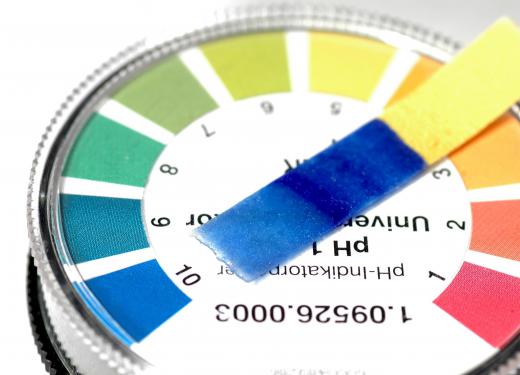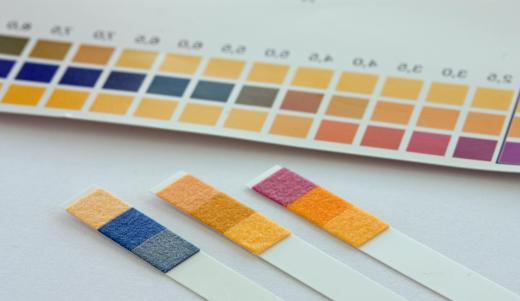What is the pH Scale?
 Mary Elizabeth
Mary Elizabeth
The pH scale takes its name from the words potential of hydrogen. It is a scale used to measure the acidity or alkalinity of a solution. The pH scale uses a range from 0 to 14, with 7.0 indicating neutrality. Numbers beginning at 7.0 and moving toward 0 indicate acidity, while the numbers beginning at 7.0 and moving toward 14 indicate alkalinity, so the scale divides acids from bases. We owe the concept of pH to Danish chemist S. P. L. Sørensen, who introduced it in 1909.
There are several categorizations for solutions as measured by the pH scale. A common one is this:
| pH 0 - 2 | Strongly acidic |
| pH 3 - 5 | Weakly acidic |
| pH 6 - 8 | Neutral |
| pH 9 - 11 | Weakly basic |
| pH 12 - 14 | Strongly basic |
It is interesting to note that while some people associate corrosion with acid, a number of organizations define pHs of both 0-2 and 11.5-14 on the pH scale as corrosive.

While litmus paper is used to indicate whether a solution is acidic or basic with a simple red/blue color indication, sometimes more fine-tuned results are necessary. To find the equivalence point in Acid-Base titration, for example, choosing the proper indicator is crucial to getting suitable results. The indicators used, such as methyl violet, Bromthymol blue, and Alizarin yellow, have very specific bands of color reaction that can be matched to the equivalence point.

A number of plants are natural pH indicators, including red cabbage, a fact you may have seen revealed in your kitchen. You may also see soil pH revealed by plants in your garden, because the pH of the soil is one of the factors that determines the success or failure of gardening ventures. Generally, plants experience their best growth in soils with a pH near neutral, though certain plants, notably blueberries and azaleas, need acid soils to grow well. One of the interesting gardening tricks accomplished by altering pH is to encourage the blossoming of blue – if the soil has a pH of 5.5 or below – or pink – if the soil has a pH of 6.5 or higher – hydrangea flowers from identical plants. Soil with a pH in between may yield purple blossoms — a mixture of pink and blue.

The pH of different substances is also of interest in other fields. The proper pH is important in determining the quality of wine, best determined using a pH meter. The pH of wine ranges from 2.9 to 4.2 and is considered best at about 3.0 to 3.5 — different wine makers give slightly different figures. The pH scale is also the measure used to determine whether paper qualifies for description as acid-free.
AS FEATURED ON:
AS FEATURED ON:















Discussion Comments
I don't know.
How many more times alkaline is a 9 from a 5?
Lead nitrate or nickel nitrate solution are acidic, but these solutions do not have hydrogen ions. Why are they acidic?
pH and oxidation are two separately measured indicators.
pH is potential hydrogen. It is on a scale from 1 to 14 where 7 is neutral. A pH of .5 or 1 is all hydrogen, so it's like the sun, so nothing is going to live in that environment.
Oxidation is based on electrons. If you drink a soda, there is high oxidation which means there are many electrons missing in the drink. It becomes hungry and will be stealing electrons from your body.
An anti-oxidant is something that has extra or donor electrons like vitamin C or Kangen Water, that replaces electrons which may be missing. That is why air (which is oxidative) will steal electrons from the air and rust it. But lemon or anti-oxidants have donor electrons and prevent the stealing of electrons at least for a while.
This may be a really silly question, but I've always wondered why pH is written the way it is. Why is the p small and the H big?
Does anyone know if there's a particular pH scale for acids? I have a report to do for my chemistry class and it would be really helpful to have a quick reference of the pH of some of the most common acids. A base pH scale would be convenient too, if anybody knows where I could get one.
Thanks!
A high pH (alkaline) can be mixed with lye or baking soda to manipulate pH. One could use electricity to split water to acidic and alkaline water like Kangen Water. Low pH is lots of hydrogen. This is when it's acidic like soda or sports drinks. Acidic drinks like these range in 2.5pH to 3.5pH.
The scale is by 10s (like the Richter scale), as 8 is 10 times more alkaline than 7 and 100 times more alkaline than 6pH. pH can be related to oxidation, as acidic drinks are usually oxidizing as well, but typically not.
a low pH will prevent the browning of apples which is an oxidation reaction. That is why adding lemon juice prevents cut apples from browning.
Effect of ph on water, if ph high what affects it ? if ph low what affects it?
IS pH related to the oxidation of materials? more specifically, is pH related to the oxidation of apples?
Is pH related -- in any way -- to oxidation?
Post your comments